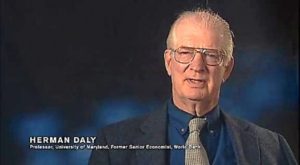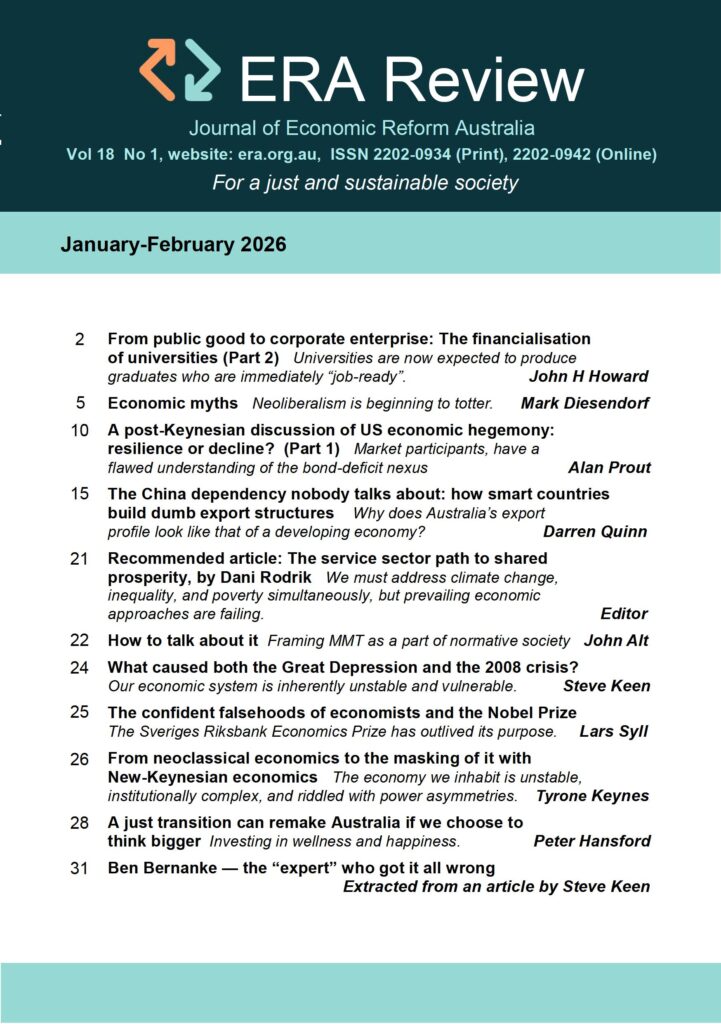A review of “Herman Daly’s ‘Economics for a Full World’: His life and ideas” – a biography by Peter Victor [1]
Matthew Washington

This is an important book. It brings insights into the life and ideas of Herman Daly, but also it reveals with clarity how much Daly has done, over many decades, to build the foundations and credentials of ecological economics. Peter Victor notes that as Daly developed his ideas, he sought input and critical comment. He engaged in debates on many key issues with several economists of note. His influence is demonstrable as he challenged many aspects of neoclassical economics and also outlined an articulate vision of what a sustainable economy could be. Peter Victor traces various themes through Daly’s publications and including his personal correspondence. Victor shows that Daly’s work has displayed intellectual courage. Daly has probed and examined many controversial issues such as: curbing population growth, reducing the through-put of materials (over production) and discouraging over consumption, while addressing inequality by regulating minimum and maximum income levels.
Daly has consistently shown that, within our western economies policies targeting unrestrained growth have not actually improved well-being, and furthermore gains arising were often not shared equitably with those social groups who could/should benefit most from such a surplus.
Victor also chronicles Daly’s endurance, as he has had to weather hostile responses arising from the controversies that his ideas engendered. Herman Daly ventured where others feared to tread since he questioned the accepted economic orthodoxy.
Peter Victor is an ecological economist himself. His thorough research shows a keen appreciation of Daly’s work. He identifies Daly’s influences, the impact of his ideas upon many of his contemporaries and the unique contribution he has made as a founder of ecological economics. As Victor notes:
“The vast number of citations to his work, the numerous testimonials, and the many prizes he has received reveal a level and scope of influence that few contemporary economists can match.”

Daly’s inspiring body of work has met with some active opposition. However, despite his heterodox views on the nature of economics, Victor notes how Daly’s obtained recognition in many quarters and attracted many awards. However, these awards did not find the recognition such achievements merited within his own academic discipline. Indeed, his economic ideas were a clear challenge to those embracing mainstream neoclassical norms which Daly questioned. Unfortunately, this poor reception to his successes and his receipt of prestigious awards, led to difficulties. Daly was not considered for some senior academic appointments and his lamentable treatment had effects on his ability to properly supervise his PhD students. Daly’s family even received threatening phone calls, while Herman was away at conferences. As Peter Victor notes:
“Marcia received phone calls deliberately intended to scare her and the children”
This deplorable treatment illustrates the hostility Daly’s heterodox economic ideas engendered amongst some academics. Finally, this situation led to Daly’s decision to remove his family elsewhere and to seek employment outside of academia in 1989.
Victor’s portrait of Herman Daly shows us many aspects to the man himself. Victor obtained some of Daly’s private correspondence and interviewed a number of Daly’s friends and contemporaries. Daly was influenced and absorbed ideas from scholars and friends in various fields and often they, in turn, were influenced by him. We learn about Daly’s intellectual curiosity, his tolerance and interest in other cultures and of his moral courage which has informed both his work and his life.
As noted Daly engaged in a number of important dialogues and debates with other economic scholars (Stiglitz, Nordhaus and Solow to name a few). For instance during the 1990s:
“Herman Daly became engaged in two substantive debates on the relevance of the laws of thermodynamics to economics, the first with Jeffrey Young and the second with Robert Solow and Joseph Stiglitz.”
For almost 6 decades he championed the central ideas of ecological economics and is an articulate advocate for our society’s transition to a Steady State Economy. As Victor notes in chapter after chapter, Herman Daly consistently displayed his:
“willingness, even compulsion, to examine controversial issues and to express unpopular points of view if that was where the evidence and his analysis led.”
Daly’s exposition of how the laws of thermodynamics reveal major flaws within the standard Neoclassical Economic theory, was challenging for many. Daly grasped the real dynamics of the western market economy and how pursuit of endless physical growth, in a world of finite resources, was not only unsustainable, but was also irredeemably bad public policy. Daly has consistently exposed how such policies have destructive consequences, both socially and environmentally.
Economics as a Life Science
In an early paper of Daly written in 1968, titled “On economics as a life science”, Victor astutely notes the powerful implications that arise from it. Daly has continued to develop themes from this paper. This paper shows that Daly saw the connectedness of economy, a human creation, and its proper place within the natural world, as totally dependent on the ecosphere. Daly came to understand that how we treat and maintain the boundaries between the economy and the ecosystem are key factors that define what is a truly sustainable economy. Daly’s work shows how poor economic models, that disregard natural systems boundaries, will drive very poor policy consequences for the economy and the environment. Victor notes that Daly:
“explored some implications of thinking of economics as a life science more akin to biology and ecology than to physics”.
Another theme was explored by Daly and Cobb in “For the Common good”. Here they applied their critical perspective to the neoclassical economic notion of ‘circular flow’. Their critique clearly finds echoes within similar critiques of “circular flow”, made in recent decades by such as heterodox economists as Kate Raworth and Steve Keen.
Upon leaving the World bank
Daly gave a remarkable farewell speech in 1994 upon leaving the bank. His comments are prescient for their time. He noted the bank should:
“ (1) Stop counting the consumption of natural capital as income;
(2) Tax labour and income less, and tax resource throughput more;
(3) Maximize the productivity of natural capital in the short run and invest in increasing its supply in the long run.
(4) Move away from the ideology of global economic integration by free trade, free capital mobility, and export led growth-and toward a more nationalist orientation that seeks to develop domestic production for internal markets. ”
Prominent names who have drawn from Daly’s Work
Victor also notes how many current economic commentators and heterodox economists have drawn inspiration from Daly’s ideas. Victor names some prominent names who now clearly offer alternative economic perspectives rejecting the dominant growth paradigm:
“* Sustainable development (World Commission on Environment and Development 1987),
* The circular economy (Ellen McArthur Foundation 2013),
* The well-being economy (wellbeingeconomy.org),
* Degrowth (D’Alisa, Demaria and Kallis 2015), and
* “the Donut Economy” (Raworth 2017),
All of which draw on Daly’s steady-state economics”
The economy, in Daly’s view, should reflects its real position within a “full world”. Daly’s position is that:
“ the Economy is embedded in the Ecosystem and fully dependent on it.”
Influences and Mentors
Daly’s had many influences and mentors, many of these being notable economists with whom he trained or sought out (e.g. Georgescu-Rogen, Kenneth Boulding, John J. Cobb jnr, Joshua Farley and many others).
Victor also examines those who have been critical of Daly’s Steady State Economy; both those from the right and from the left. In the context of the history of ideas Daly’s views signalled a needed paradigm shift. Victor notes:
“Daly learned of this resistance to paradigm change within economics, when his ideas and influence began to spread. Soon after he began writing about the steady-state economy it became the subject of criticism, first from orthodox economists seeking to defend their views on economic growth, then from heterodox economists – including his mentor Georgescu-Roegen, and later from the left end of the ideological spectrum which includes advocates of degrowth and Marxists.”
However, Daly’s work has been a beacon of sanity to many. Daly delineates how societies can transition to a Sustainable Steady State Economy (i.e. SSE), which can be both a viable policy choice and a morally desirable aim. Daly also explores the notions of purpose and what he calls our “intermediate ends” and our “ultimate ends”. In this way Daly has a philosophic appreciation of human culture. Economics seeks to identify what decisions bring important changes to/for our society. Such decisions show the importance of good public policy. Daly’s ideas have shifted our focus onto the role and input that communities make and how change can flow from what they come to value. Daly’s perspective is not prescriptive. His is a positive orientation towards economics as a tool to solve human problems, while respecting our dependence within and upon the natural world.
Since Economics is a social science, policy choices have important social and environmental consequences. Consequently, human capacity to cooperate is present, along with our capacity to compete and strive for excellence. In this context Daly clearly identifies the importance of policy intent. For the ‘common good’ is a relevant social impulse, which he notes can shape better economic outcomes.
Hence, Daly’s vision is not the neoclassical model of an idealised individual trapped in and economic juggernaut driven relentlessly by the extrinsic forces of the market. Daly’s perspective provides a clear vision of an economy we can be build and situate within and connected to the greater whole of the natural world. Hence the economy is a ‘human creation’ that can sustain us, but must respect and reflect our dependence upon the natural world.
Daly’s views on the SSE have not only served as a catalyst for dissent, but also his influence is a refreshing counter point to the faltering and increasingly irrelevant neoclassical orthodoxy. As victor notes:
“Herman was not prepared to compromise his intellectual integrity and refrain from expressing disagreement simply because it made some people uncomfortable.”
Yet, Victor also shows us that Herman Daly is a humble and modest man who earnestly sought to learn from the debates and dialogues his papers and books inspired. So, Daly’s ideas remain a real force in what some call a paradigm shift, away from the moribund ideas of neoclassical economics. Lastly I echo Victor’s well-chosen comment:
“ And most important of all, what can we learn from him that will help us cope well with the threats and opportunities of the twenty-first century? “
1. Victor, Peter A, Herman Daly’s Economics for a Full World (Taylor and Francis, Kindle Edition)

Dr Peter A. Victor is a Professor Emeritus in Environmental Studies at York University. He has worked for nearly 50 years in Canada and abroad on economy and environment as an academic, consultant and public servant.
Em Prof Peter A. Victor; Taken from CANSEE
website: https://cansee.ca/pvictor/
Matthew K. Washington has an MA in Philosophy (Sydney Univ) and also MTax (UNSW). He is interested in social philosophy, philosophy of science, epistemology, and international tax issues. He has worked in the ATO, has analysed large multinational corporations, and has been Co-Director of CASSE NSW for many years.































Pingback:Embrace more economic growth at our peril – Balanced News Summary